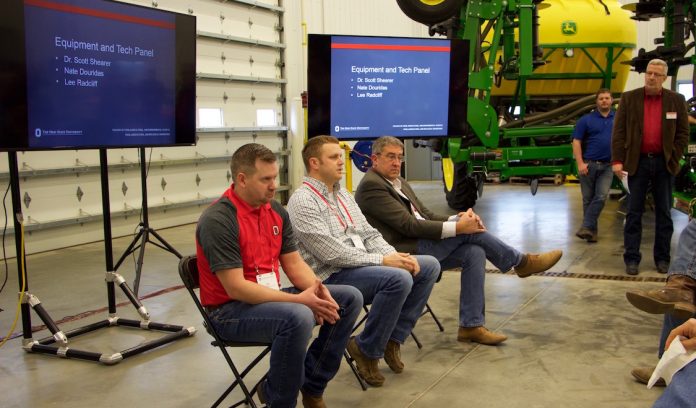
LONDON, Ohio — Nutrient management has been a hot topic among Ohio farmers over the past few years.
With new regulations in place for producers applying manure and fertilizers to their crops, Ohio State University’s second annual Precision University turned its focus on nutrient management to show farmers how to better manage their resources and share the latest technologies available to help.
The conference was held Jan. 11, at Beck’s Hybrids in London, Ohio. More than 150 producers and industry members attended, which is an increase from the 80 attendees at last year’s event, said Kaylee Port, program manager for the precision agriculture program at Ohio State.
Attendees came from across Ohio and neighboring states to hear from research and industry professionals and discuss precision agriculture and nutrient management.
Soil sampling
Farmers are not doing enough on-farm testing, according to Brian Arnall, precision nutrient management specialist at Oklahoma State University.
“We should be constantly checking our fertility,” he said. “Each year, we should be able to adjust on the fly.”
And it won’t cost you an arm and a leg to do it.
Arnall said farmers don’t need special yield monitors or expensive calibrators to perform soil tests. Using a cheap $40 spreader, farmers can test a strip of land at any given time.
Taking the time to do a proper soil test makes getting a proper nutrient balance that much easier.
Robert Mullen, director of agronomy for Nutrien, said the goal of soil sampling is to estimate the average soil test level within a given area, using both accuracy and precision.
Due to variability in fields and soil testing, farmers must collect an adequate amount of soil samples to avoid “squiffy” data, he added.
Managing soil
After collecting samples, how do farmers process it all?
“Management is not just a one-time activity,” said Jamie Bultemeier, director of corporate sales and agronomist at A&L Great Lakes. Farmers should be looking over their data for the past three to four years to see where they have been and where they are going.
Bultemeier also suggested soil tests and nutrient application should happen in different seasons — “you have time.” For example, take the winter months to evaluate the results from the sample you took in the late fall or early winter, so that you can make decisions for best practices in the spring.
Bultemeier also suggested that soil sampling can take place any time of year, not just directly after harvest, which has been a common practice for many.
Nitrogen application
“Every year is different. Every hybrid is different. Every soil type is different. So why do we treat them all the same?” asked Jim Schwartz, director of practical farm research and agronomy at Beck’s Hybrids.
He said, farmers tend to make their decisions on applying nitrogen in the early stages of the planting season, which leaves a greater margin for error. For example, wet springs can lead to nutrient wash-out or replanting.
“Use that early planting season to gather data and sidedress with nitrogen,” said Schwartz. Waiting to apply nitrogen allows you to make decisions on how much to use and keep it in the field when it is needed, he explained.
Technology and equipment panel
During a breakout session, Ohio State’s Department of Food, Agriculture and Biological Engineering Chair Scott Shearer joined Farm Science Review farm manager Nate Douridas and Ohio farmer Lee Radcliff to discuss new technologies on the farm.
Douridas said using a two-by-two planter and fertilizer system, he is able to inject fertilizer down both sides of a row when planting. He can input a prescription for each side of the plant rows to get just the right amount of fertilizer or nutrient application in that row.
Douridas said he also uses a series of aerial maps to check crop and soil conditions on a regular basis.
Lee Radcliff, a farmer near Circleville, Ohio, said his farm has used unmanned aerial vehicles to try to detect nutrient deficiencies in crops. But using above-the-field imagery doesn’t give you the full picture, he warned.
“By the time you see nitrogen recovery in the crop canopy, it’s too late,” he said.
Shearer said new technology is being developed that can detect nutrient deficiency in the plants at the root. “New technology (in agriculture) is starting to come at a faster pace,” said Shearer.
But, Radcliff noted, being able to buy those new technologies can be a struggle for producers. “We need to be able to use it and afford it,” he said, noting he wants to be an early adapter of new technologies that will help him react before it’s too late.











